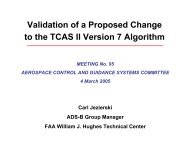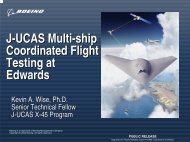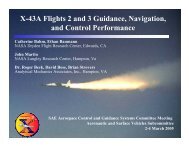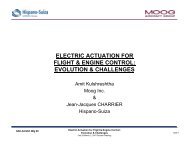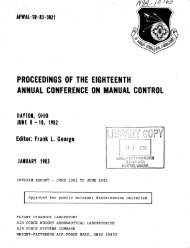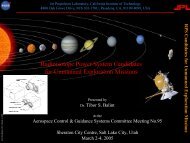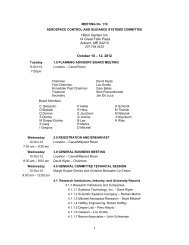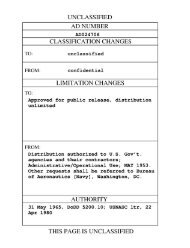Report of the Second Piloted Aircraft Flight Control System - Acgsc.org
Report of the Second Piloted Aircraft Flight Control System - Acgsc.org
Report of the Second Piloted Aircraft Flight Control System - Acgsc.org
Create successful ePaper yourself
Turn your PDF publications into a flip-book with our unique Google optimized e-Paper software.
conrtsnt speed). While this ryrtem worked and <strong>the</strong> pilots experienad<br />
no difficulty in flying it, <strong>the</strong>y were unanimous in condamming<br />
it. Unfortunately no one flew it who had had no ezperience in aa<br />
airplan.. TUr might have shorn 'nor natural a method <strong>of</strong> control it<br />
in.<br />
The control position feedback was unnaturally related to <strong>the</strong> force<br />
feedbe. The wheel--rigidly connected to <strong>the</strong> ailerons-followed thin<br />
emteblimhbg a bank. Ar every pilot knows, <strong>the</strong> no& requeme <strong>of</strong><br />
wento is romething like this:<br />
1. The whed is rotated into <strong>the</strong> turn.<br />
2. It is held in a deflected position.<br />
3 Then it 'in returned toward neutral.<br />
4. Finally it is slightly rotated oat <strong>of</strong> <strong>the</strong> turn<br />
and held <strong>the</strong>re to counteraat <strong>the</strong> overbanking<br />
tendell~y.<br />
With this first 8yst.m <strong>the</strong> automatic pilot did all tnir while 'tlu<br />
pilot maintained a conrtant aileron force. It's almort iapoeeible to<br />
beliwe, but neverthderr tme: not only way control smooth and stray,<br />
bat nobow objected to this peculiar porition feedback. The objectionr<br />
ware aoncerned with <strong>the</strong> magnitude <strong>of</strong> tbe forcer required to maintain<br />
tb. aircraft in a steady tm. There objectiona, might have been wercome<br />
by using wa.hout or nonlinear gradientr or both. Brief eqsrimanta<br />
ware conducted with a strong centering characteristic and a<br />
low rtiuk force gradlent for mod'arate diaplacementr. Thir artearr<br />
like a carn reanr <strong>of</strong> control, with or without nonlinear gradientr,<br />
howww, did not meet with agproval and was qulckly abandoned.<br />
The next configuration which was tried war designed as a first<br />
step toward making <strong>the</strong> aircraft control characteristics correspond to<br />
those <strong>of</strong> a conventional aircrait. Specifically, <strong>the</strong> roll control<br />
channel war alt sred in such a way that whenemor an aileron f orce<br />
grater than three pounds war applied, <strong>the</strong> vertical gyro roll signal<br />
and vertioal gpro roll erection were removed, and, by means <strong>of</strong> a<br />
ratchet relay, raalned dilrconnected until a button on <strong>the</strong> control<br />
wheel war deprersed.<br />
The mdder channel was modified as followr: <strong>the</strong> directional gyro<br />
rignal was completely removed and a lateral accelerometer was rubstituted<br />
ar a yau reference device. !Chis configuration reeulted in a<br />
control characteristic in which wheel force in roll commaaded an aileron<br />
displacement (and <strong>the</strong>refore rate <strong>of</strong> roll at a given airepeed)



